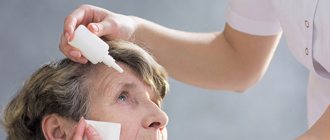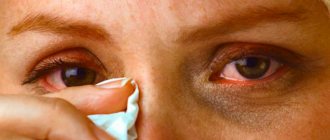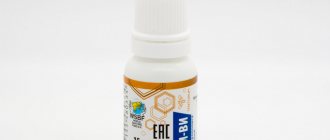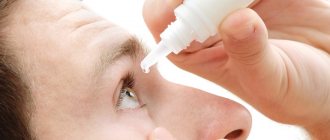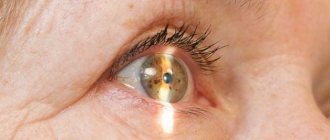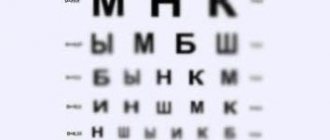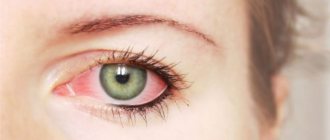Operating principle of a refractometer
The functional purpose of a refractometer is to measure the refractive index of light in an aqueous emulsion or solution.
The main optical element of this device is the measuring prism (main prism). The materials from which it is made have a high refractive index. The coolant, the concentration of which must be measured, is applied to the protective glass, tightly adjacent to the lens. Daylight, passing through the coolant layer and the main prism, is refracted and falls on the refractometer scale. The concentration of the cutting fluid is expressed as a percentage based on the location of the light and shadow boundary on the scale.
The value of the refractive index of the beam (refraction) is influenced by the optical characteristics of the base fluid and the components dissolved in it, including the coolant concentrate. The refractive index of a beam is defined as the ratio of the angles of incidence and reflection of a light beam at the boundary of media.
An example of the successful use of a refractometer to analyze the desired qualities of a cosmetic product
Typically, manufacturers of lotions, creams, shampoos, shower gels and other similar products around the world face similar challenges: using a refractometer, they need to measure the refractive index of their final products and raw ingredients in order to ensure product quality control and maximum organize reporting effectively. As an example, consider a typical cosmetic product such as body wash. This product contains water, surfactants or detergents, antibacterial compounds, fragrances, essences, and in some cases pH adjusters. While we are unable to determine the concentration of individual components in a finished product using a refractometer, measuring the refractive index of the raw material or final product is important to ensure that the product is consistent with the current formulation, batch to batch. And since the stable refractive index of the final product allows us to draw conclusions that all components are present in it in the correct concentrations, this also guarantees that with subsequent use of the analyzed cosmetic product, all its desired qualities will be fully manifested.
To determine refractive indices in the cosmetics industry, miniature models of modern digital refractometers are primarily appropriate. As a rule, they are not very expensive, and, at the same time, they are extremely convenient and easy to use and have high accuracy and speed of measurements. However, it is desirable that your future refractometer be equipped with an auxiliary ATC function and be made of easy-to-clean materials with high strength and durability. As for ease of use, most modern instruments that measure refractive indexes are controlled using 2-3 buttons, so that even “non-scientific” users can easily make measurements.
Based on materials from the Hanna Instruments blog
Refractometer Calibration
Before taking measurements, it is necessary to calibrate the refractometer. This process consists of the following steps:
- After lifting the daylight protective cover, apply 2-3 drops of clean water to the prism to dilute the coolant.
- Distribute the water under the daylight protective cover over the entire surface of the prism, then lower the cover.>
- Check the water layer for dry spots or air bubbles. Within 15...30 s. the temperatures of the water and the refractometer are equalized.
- Pointing the device in the direction of the light, adjust the focus of the eyepiece so that the graduated scale is clearly visible.
- Using the calibration screw, set the zero scale division at the border of the upper blue and lower white areas.
- Use a cloth to remove distilled water from the surface of the prism. The refractometer is ready for use.
If the ambient temperature has changed by 3-4 °C, it is necessary to recalibrate.
What refractometers are there?
The special equipment market includes laboratory, industrial and portable refractometers. The devices are accurate and easy to use. At home, portable models are more common than others, because they are easy to use, but the readings they provide are not absolutely accurate.
The following types of equipment can be used in a home laboratory:
- devices for measuring sugar concentration. In order to determine your sugar level, the easiest way is to use a refractometer. The instrument provides readings in Brix units, and the data obtained can be deciphered using a special table. The range of values rarely exceeds 40 Brix, but this range is sufficient to work with alcoholic beverages of all types;
- devices for measuring ethanol concentration. Another type of refractometer measures the alcohol level in a solution. Readings are given in % of volume. This measuring device is similar in characteristics to an alcohol meter.
If you decide to buy a refractometer, it is important to consider that the device only gives accurate readings when working with two-component solutions. For example, it will be difficult to obtain readings on the exact sugar concentration in wines, since the drinks contain acids. The situation is similar with cognac and other aged alcohol when measuring the alcohol concentration in it. The refractometer gives the most accurate indicator of alcohol content when working with distillate and vodka. As for measuring alcohol content in wine or beer, this device is not suitable at all.
In addition to the composition of the liquid, temperature and other environmental factors must be taken into account. Most experts agree that it is best to take measurements at an air temperature of no more than 20°C, but there are models that can operate over a wider temperature range. For this reason, we advise you to carefully study the instructions for the device before purchasing, and during operation follow all the manufacturer’s recommendations.
Taking measurements using a refractometer
The concentration of the cutting fluid is measured when it is first mixed with water, and then the measurement process is repeated every few days. To determine the coolant concentration, you must perform the following steps:
- Lifting the protective cover of the daylight, apply 2-3 drops of coolant to the dry prism.
- Distribute the liquid under the daylight protective cover over the entire surface of the prism.
- After making sure that there are no dry spots or air bubbles in the sample layer, lower the daylight cover.
After 15...30 s. the boundary line between the blue and white areas on the refractometer scale will indicate the concentration of the cutting fluid (in %).
To calculate the coolant concentration for different product groups, you need to multiply the resulting result by a correction factor:
- for coolant with a high content of mineral oil – 1.0;
- for coolant with an average mineral oil content – 1.1;
- for coolant with low mineral oil content – 1.4;
- for synthetic coolants without mineral oil content – 2.0.
More precise refractive index values are indicated in the technical information for specific products.
If the boundary between the scale zones is blurred, this indicates that the sample is contaminated with foreign greases and oils. If there is no dividing line between the boundaries, then the level of contamination is high and the coolant in the system must be replaced.
Do not turn the calibration screw during measurements!
Why do you need to calibrate the device?
In order for the refractometer scale to show accurate results, it is necessary to prepare the instrument for use and carry out the calibration procedure. For such purposes, the most common distilled water is used. It is needed in order to set the value to zero. It is known that distilled water does not affect the refraction of light in the lens in any way - it gives a zero coefficient.
To prepare the device, apply a little distilled water to the main lens using a pipette. Then the device is closed and set to zero using the calibration screw. When the value 0.0 is set, you need to clean the lens with a special cloth. After such a little preparation, you can conduct research - the refractometer will display the refractive index very accurately.
You can set up the TechLube RB-18 ATC handheld refractometer in the manner described above. It is very easy to use. After calibration, the device gives accurate values. Using the device is not difficult - just repeat the same steps as during calibration, without touching only the calibration screw.
To carry out measurements, you need to apply a substance to the lens with a pipette, then you need to close the glass and wait about 30 seconds. When 30 seconds have passed, you can point the device at any available light source. It could be the sun or a light bulb - the power source will not affect the value. The refractometer will display the refractive index even in dim lighting.
The main thing is not to touch the calibration screw during the measurement process, otherwise you will have to carry out the entire procedure from scratch. When you have to carry out many measurements using different liquids, it is worth calibrating the device and cleaning it more often. Otherwise, errors in the indicators are possible.
Caring for your refractometer
A refractometer is a precision optical instrument. That is why it requires special attention during operation and storage.
To maintain the integrity of the prism surface, it should be cleaned in a timely manner and prolonged contact of this element with acids or alkalis should be avoided. Failure to comply with these recommendations will inevitably lead to loss of instrument accuracy and, as a result, distortion of measurement results.
At the end of the measurements, using a soft cloth moistened with water or another (for example, alcohol-containing) solvent, it is necessary to thoroughly rinse the prism and protective glass of the refractometer, completely removing any remaining coolant and oils in the samples. After this, you need to wipe the prism and glass dry.
Do not put the refractometer in water! Fogging of the device is a sign that water has got inside it. The refractometer should be stored at room temperature in its case. Prolonged exposure of the device to open sunlight, shock and vibration is unacceptable. Proper care of your refractometer can ensure long-term reliable operation of the device.
Types of refractometers
There are four main types of refractometers:
- Manual;
- Digital;
- Laboratory;
- Industrial.
Devices of the last two groups are used in various research institutes and enterprises. As a rule, these are large stationary installations, the main advantage of which is the high accuracy of the measurements. Manual and digital refractometers, on the other hand, are relatively compact in size and easy to transport. Most often they can be found in auto repair shops and service stations. Digital devices often come with a number of additional features. For example, in addition to the angle of refraction, they can determine the density of the composition.
Example of a simple device
An example of a simple but effective device is the TechLube RB-18 ATC. An optical refractometer is ideal for measuring the concentration of water-miscible cutting fluids. It has an automatic temperature compensation system, which sets it apart from many similar devices. If the temperature of the test composition changes, this will not affect the refractometer readings.
The device guarantees high measurement accuracy in any conditions. You can take the device with you on the road, use it in a laboratory, at an enterprise, in a car service center or in a garage. The refractometer will not take up much space.
The device is resistant to mechanical damage. To calibrate it, it is enough to have some distilled water. TECHLUBE offers discounts when purchasing refractometers in this series in bulk. The service life of such devices is long, they are reliable and practical. The durability of the device is ensured by its relatively simple design and high build quality.
TechLube RB-18 ATC has a comfortable rubberized handle that does not slip in your hands. Even if your hands are covered in oil, the device will not slip out. The manufacturer has thought through the design of the refractometer down to the smallest detail, taking into account the specifics of its application.
November 18, 2016



